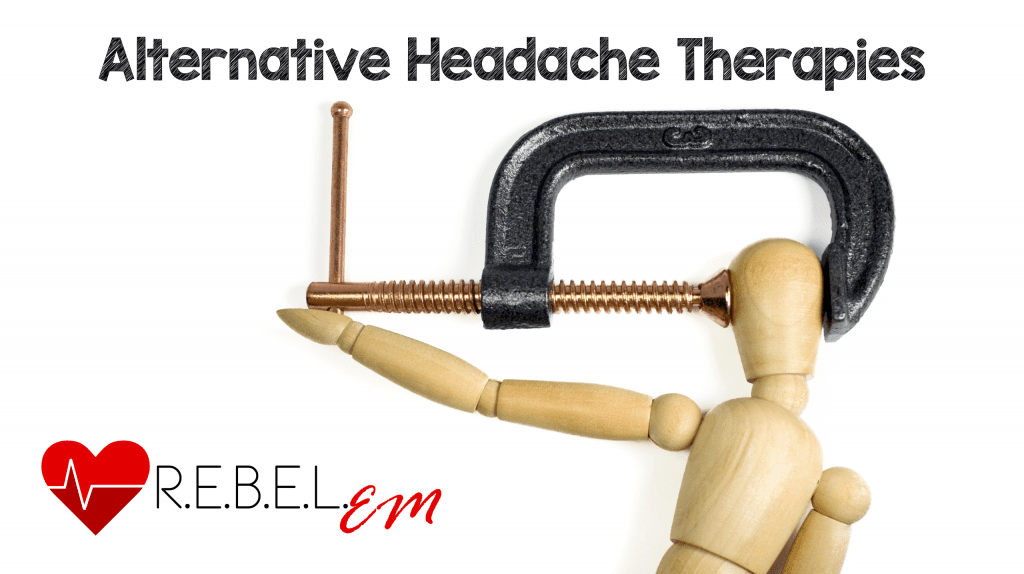 Background: Presentations to the Emergency Department for acute headache are remarkably common, with more than 2 million visits each year in the United States (Goldstein 2006). Emergency clinicians are tasked with dual roles of excluding life-threatening pathology while rendering effective pain relief and symptomatic care. Treatment patterns for isolated benign headache are widely variable, reflecting the array of symptoms and diversity of therapeutic response among patients presenting for care. One observational cohort of ED patients reported the routine use of 36 different medications for the treatment of headache, with most patients receiving more than one parenteral agent, as well as frequent use of opioid therapy despite recommendations to avoid the same except as a last resort (Vinson 2002). While a variety of effective medications are available for treatment of primary headache in the Emergency Department, including NSAIDs, neuroleptics, anti-emetics, anti-epileptics, and more, there is a growing interest in alternative headache therapies that offer rapid relief without the side effects and time investment of more traditional agents.
Background: Presentations to the Emergency Department for acute headache are remarkably common, with more than 2 million visits each year in the United States (Goldstein 2006). Emergency clinicians are tasked with dual roles of excluding life-threatening pathology while rendering effective pain relief and symptomatic care. Treatment patterns for isolated benign headache are widely variable, reflecting the array of symptoms and diversity of therapeutic response among patients presenting for care. One observational cohort of ED patients reported the routine use of 36 different medications for the treatment of headache, with most patients receiving more than one parenteral agent, as well as frequent use of opioid therapy despite recommendations to avoid the same except as a last resort (Vinson 2002). While a variety of effective medications are available for treatment of primary headache in the Emergency Department, including NSAIDs, neuroleptics, anti-emetics, anti-epileptics, and more, there is a growing interest in alternative headache therapies that offer rapid relief without the side effects and time investment of more traditional agents.
Sphenopalatine Ganglion Block:
A small body of literature has suggested that the application of intranasal lidocaine to perform a sphenopalatine ganglion block may be effective in the treatment of primary headache (Maizels 1999) (Robbins 1995). Most data are confined to case series and patients with post-dural puncture headaches (Kent 2016), and two randomized clinical trials in ED patients have failed to show benefit (Schaffer 2015) (Blanda 2001). Nonetheless, due in part to widely reported anecdotes of success, provider comfort with local anesthetics, and the wide safety window of lidocaine, use of this technique continues to grow.
Sphenopalatine ganglion block is often performed using one of two methods:
1) Long cotton applicators are soaked in 4% viscous lidocaine and then inserted into the bilateral nasopharynx until the point of resistance. They are left in place 10 minutes, at which point the patient is reassessed.
or
2) 2% lidocaine is loaded into a syringe fitted with an atomization device. 2ml of lidocaine in instilled into the bilateral nares and pressure held for 30 seconds. The patient is reassessed 10 minutes following the procedure.
More information on sphenopalatine ganglion block can be found at ALIEM, here.
Paraspinous Cervical Nerve Block:
Occipital Nerve Block (ONB) is a common therapy for cervicogenic headache. While robust data supporting its use are lacking, multiple open-label trials and observational cohorts, as well as clinical experience, support the technique (Tobin 2009) (Levin 2010). Extrapolating the practice, Mellick et al. in 2006 published a retrospective review of 417 patients who received intramuscular injections of bupivacaine lateral to the sixth or seventh cervical vertebrae. Astoundingly, more than 65% of patients reported complete relief of their headache with this technique. No significant complications were reported (Mellick 2006). More rigorous investigations have yet to be completed, however the technique continues to grow in popularity due to shared anecdote.
After preparation of a sterile field, 1.5 mL of 0.5% bupivacaine is injected 1 to 1.5 inches into the paraspinous musculature 2 to 3 cm bilateral to the spinous process of the sixth or seventh cervical vertebrae using a 1.5-inch 25-gauge needle.
An excellent demonstration of paraspinous nerve block by Dr. Mellick can be found here.
Low-dose Propofol Therapy:
Numerous case reports and series (Drummond-Lewis 2012) (Soleimanpour 2012) (Bloomstone 2007), retrospective reviews (Mendes 2002) (Sheridan 2012), and randomized trials (Soleimanpour 2000) (Simmonds 2009) have proven the efficacy of propofol in the treatment of primary headache. While some hospital regulations may restrict the use of propofol or require more significant resource utilization when used, the practice is similar in many ways to the use of analgesic doses of ketamine in the emergency department. When administered in 20-30 mg aliquots every 3-5 minutes until relief of pain, more than 80% of patients report complete resolution of symptoms (Krusz 2000). Patients should be monitored for respiratory depression and hypotension, however no significant adverse effects have been reported in trials utilizing such minute doses. Clinical experience suggests that this technique allows for rapid symptom relief and often more speedy disposition than traditional agents.
Clinical Bottom Line:
In selected patient populations, alternative therapies such as sphenopalatine ganglion block, paraspinous cervical nerve block, and low-dose propofol therapy offer additional and potentially effective opioid sparing modalities for the patient presenting with acute primary headache. Additional data are needed to investigate the efficacy of these techniques, however they appear to be safe and well-tolerated.
Guest Post By:

Rick Pescatore, DO
Assistant Director of Emergency Medicine Research
Inspira Health Network
Vineland, NJ
Twitter: @Rick_Pescatore
References:
- Goldstein, J. N., et al. “Headache in United States Emergency Departments: demographics, work‐up and frequency of pathological diagnoses.” Cephalalgia6 (2006): 684-690. PMID: 16686907
- Vinson, David R. “Treatment patterns of isolated benign headache in US emergency departments.” Annals of emergency medicine3 (2002): 215-222. PMID: 11867972
- Maizels, Morris, and Ann M. Geiger. “Intranasal lidocaine for migraine: a randomized trial and open‐label follow‐” Headache: The Journal of Head and Face Pain39.8 (1999): 543-551. PMID: 11279923
- Robbins, Lawrence. “Intranasal lidocaine for cluster headache.” Headache: The Journal of Head and Face Pain2 (1995): 83-84. PMID: 7737866
- Kent, Sheffield, and Gregory Mehaffey. “Transnasal sphenopalatine ganglion block for the treatment of postdural puncture headache in obstetric patients.” Journal of Clinical Anesthesia34 (2016): 194-196. PMID: 27687372
- Schaffer, Jason T., et al. “Noninvasive sphenopalatine ganglion block for acute headache in the emergency department: A randomized placebo-controlled trial.” Annals of emergency medicine5 (2015): 503-510. PMID: 25577713
- Blanda, Michelle, et al. “Intranasal lidocaine for the treatment of migraine headache: a randomized, controlled trial.” Academic Emergency Medicine4 (2001): 337-342. PMID: 11282668
- Tobin, Joshua, and Stephen Flitman. “Occipital nerve blocks: when and what to inject?” Headache: The Journal of Head and Face Pain10 (2009): 1521-1533. PMID: 19674126
- Levin, Morris. “Nerve blocks in the treatment of headache.” Neurotherapeutics2 (2010): 197-203. PMID: 20430319
- Mellick, Larry B., S. Timothy McIlrath, and Gary A. Mellick. “Treatment of Headaches in the ED With Lower Cervical Intramuscular Bupivacaine Injections: A 1‐Year Retrospective Review of 417 Patients.” Headache: The Journal of Head and Face Pain9 (2006): 1441-1449. PMID: 17040341
- Drummond‐Lewis, Jacqueline, and Corey Scher. “Propofol: a new treatment strategy for refractory migraine headache.” Pain Medicine4 (2002): 366-369. PMID: 15099247
- Soleimanpour, Hassan, et al. “Improvement of refractory migraine headache by propofol: case series.” International journal of emergency medicine1 (2012): 19. PMID: 22587626
- Bloomstone, Joshua Aaron. “Propofol: a novel treatment for breaking migraine headache.” The Journal of the American Society of Anesthesiologists2 (2007): 405-406. PMID: 17264748
- Mendes, Paula M., et al. “Intravenous propofol in the treatment of refractory headache.” Headache: The Journal of Head and Face Pain7 (2002): 638-641. PMID: 12482216
- Sheridan, David C., et al. “Low-dose propofol for the abortive treatment of pediatric migraine in the emergency department.” Pediatric emergency care12 (2012): 1293-1296. PMID: 23187986
- Soleimanpour, Hassan, et al. “Effectiveness of intravenous dexamethasone versus propofol for pain relief in the migraine headache: a prospective double blind randomized clinical trial.” BMC neurology1 (2012): 114. PMID: 23020264
- Simmonds, Mark K., et al. “The effect of single-dose propofol injection on pain and quality of life in chronic daily headache: a randomized, double-blind, controlled trial.” Anesthesia & Analgesia6 (2009): 1972-1980. PMID: 19923528
- Krusz, John Claude, Virginia Scott, and Jeanne Belanger. “Intravenous propofol: unique effectiveness in treating intractable migraine.” Headache: The Journal of Head and Face Pain3 (2000): 224-230. PMID: 10759925
Post Peer Reviewed By: Anand Swaminathan (Twitter: @EMSwami) and Salim Rezaie (Twitter: @srrezaie)



